Joint Optimization Strategy for Video Transmission over Distributed Cognitive Radio Networks
2015-01-12LIUFaZHAOHonglin赵洪林MAYongkui马永奎
LIU Fa (刘 法), ZHAO Hong-lin (赵洪林), MA Yong-kui (马永奎)
Communication Research Center, Harbin Institute of Technology, Harbin 150001, China
Joint Optimization Strategy for Video Transmission over Distributed Cognitive Radio Networks
LIU Fa (刘 法)*, ZHAO Hong-lin (赵洪林), MA Yong-kui (马永奎)
CommunicationResearchCenter,HarbinInstituteofTechnology,Harbin150001,China
A novel joint optimization strategy for the secondary user (SU) was proposed to consider the short-term and long-term video transmissions over distributed cognitive radio networks (DCRNs). Since the long-term video transmission consisted of a series of short-term transmissions, the optimization problem in the video transmission was a composite optimization process. Firstly, considering some factors like primary user’s (PU’s) collision limitations, non-synchronization between SU and PU, and SU’s limited buffer size, the short-term optimization problem was formulated as a mixed integer non-linear program (MINLP) to minimize the block probability of video packets. Secondly, combining the minimum packet block probability obtained in short-term optimization and SU’s constraint on hardware complexity, the partially observable Markov decision process (POMDP) framework was proposed to learn PU’s statistic information over DCRNs. Moreover, based on the proposed framework, joint optimization strategy was designed to obtain the minimum packet loss rate in long-term video transmission. Numerical simulation results were provided to demonstrate validity of our strategies.
videotransmission;distributedcognitiveradionetworks(DCRNs);jointoptimizationstrategy;packetlossrate
Introduction
With the rapid development of video applications, more bandwidths for supporting the novel multimedia techniques are required. Currently, the spectrum usage and management are controlled by the Federal Communications Commission (FCC), USA, which regularly assigns spectrum resource to different users for various applications. However, a large portion of fixed allocated spectrum resource is not utilized efficiently. Cognitive radio technology, as an intelligent technique to access the idle spectrum resource, has attracted much attention[1]. In cognitive radio networks (CRNs), the secondary user (SU) intelligently searches and accesses the available spectrum resources to maximize their own performance, meanwhile satisfying the primary user’s (PU’s) interference tolerant limitation. The essence of cognitive radio technique consists of two parts. (1) Spectrum sensing: SU accomplishes spectrum sensing and access in the short-term transmission. (2) Dynamic spectrum access management: based on PUs’ transmission statistics, the available spectrum resources are intelligently selected by SU in long-term transmission[2-4].
For the long-term transmission, SU performs spectrum dynamic access using the partially observable Markov decision process (POMDP)[3]. On one side, in Ref. [4], to maximize the throughput, a separation principle was designed to transform the constrained POMDP into an unconstrained one. A cross-layer optimization for multimedia transmission was performed for SU to optimize the multimedia intra refreshing rate of the application layer parameter[5]. On the other side, for the optimization problem in the short-term communication, Chenetal.[6]proposed an energy detection scheme to formulate the tradeoff between sensing time and transmission time. Furthermore, Ref. [7] considered the non-synchronization problem between PU’s action and SU’s action. An adaptive sensing technique to maximize spectrum utilization was considered in Ref.[8]. Reference [9] modeled a cross-layer optimization, where cross-layer parameters were considered in physical layer, media access control (MAC) layer, and application layer, to improve SU’s short-term experience. A novel QoE-driven channel allocation scheme for SUs with cognitive radio base station (CRBS) was proposed[10]. Luoetal. designed a channel allocation scheme for smooth video delivery to maximize the overall network throughput in CRNs[11].
However, either short-term optimization or long-term optimization is considered in these papers, which is insufficient to guarantee the QoS performance of video transmission. In this paper, the contributions are as follows. (1) In the short-term video communication, we adopt the M/M/1/m queuing model to describe the video packet transmission. Furthermore, considering the practical factors in distributed CRNs (DCRNs), such as non-synchronization between SU and PU, PU’s tolerant collision probability limitation on each channel, and SU’s limited buffer size, the short-term optimization problem is formulated as a mixed integer non-linear programming (MINLP) to minimize the block probability of video packets. (2) In the long-term video transmission, based on the optimal reward functions obtained in short-term video transmission, we adopt a POMDP framework to learn the PUs’ long-term statistics on channel usage. Meanwhile, through this framework, packet loss rate is minimized to satisfy the long-term QoS performance of multimedia transmission.
1 System Model
In DCRNs, we considerNchannels which can be activated byNPUs independently, where bandwidth of each channel isBi(i= 1, 2, …,N). The slot structure is adopted in DCRNs. The evolution of PU’s channel usage is modeled as the continuous-time Markov chain, where PU’s traffic transmission in channeli(i= 1, 2, …,N) is formulated as M/M/1 queuing model with parametersλP-iandμP-i. The channeliin slotkhas two states, which areSi(k)=0 (busy) andSi(k) = 1 (idle).
Moreover, since PU has the higher priority to access the channels, PU can access the channel at any time without considering SU’s communication. Note that SU’s long-term multimedia transmission is partitioned into multiple short-term transmissions. In the short-term transmission, SU adopts M/M/1/m to describe the actions of video packets, where the arrival rate and service rate areλSUandμSU, respectively. We assumemis the SU’s buffer size, and the packet block probability is the probability of full buffer. Using the block probability of video packets as the reward function, the MINLP optimization is proposed to minimize packet block probability in the short-term transmission. Based on the imperfect partial sensing results and the minimum block probability of video packets obtained in short-term process, SU adopts the POMDP framework to model PUs’ communication statistics and minimize the packet loss rate of video packets in the long-term video transmission. Finally, through the combination of short-term and long-term optimizations, the joint optimization strategy is proposed. Figure 1 illustrates the SU joint optimization strategy for video transmission over DCRNs.

Fig.1 Joint optimization strategy for video transmission over DCRNs
2 Analytic Model for Joint Optimization Strategy
2.1 Short-term optimization process
SU firstly accomplishes the spectrum sensing in short-term transmission. The energy detector is adopted as SU’s spectrum sensor. The PU’s signalssiand noise’s signalsnireceived at SU are modeled as independent white Gaussian processes. Meanwhile, the channel sensing result can be formulated as a binary hypothesis test[12].
(1)


(2)


(3)

(4)


(5)


(6)
whereLis the sensing time andρiis the SU’s practical traffic load at channeli.
2.2 Long-term optimization process
Under the constraint of battery capacity and hardware complexity, SU cannot obtain all channel state information of DCRNs. Therefore, based on the partially available information and imperfect sensing results from the short-term optimization, the POMPD framework is adopted to model the uncertainty of PUs’ statistic activity information. Meanwhile SU can interact with DCRNs in order to learn a joint policy to minimize the packet loss rate[13], where the interaction process is illustrated in Fig.2.

Fig.2 The POMDP framework
(1) Network states and state transition probability
Since PU’s each channel state is denoted by 2-state discrete Markov model with state “s(k) = 0” or “s(k) = 1”, the total states of DCRNs and single network state areZ= 2Nand DCRNs state zi∈Q (i∈{1, 2, …, 2N}) in slotk. Meanwhile, the channel transition probability Pi(s(k), s(k+1)) at channelifrom slotktok+1 represents the states(k) in slotktransmits tos(k+1) in slotk+1. Therefore, the transition probability Pi(s(k)=1, s(k+1)=1) from idle state to idle state is given by
e-λP-iT,
(7)

(2) Action space, observation space, and observation probability

(3) Belief state vector



(8)

(4) Reward and policy
The immediate rewardR(zi(k),A(k)) in the POMDP framework is defined as the value that SU receives by action set A(k)={as(k)=i, aPBR(k), ac(k)} with network statei. Packet loss ratePPLRis designed as the immediate rewards, which is defined as
R(zi(k), A(k))=PPLR=θPPBR.
(9)
Through immediate reward minimization, SU can map an optimal action set A(k)={as(k)=i, aPBR(k), ac(k)} (k=1, 2, …, W) to the belief vector b(k). Therefore, the optimal joint policyπ*for video transmission in totalWslots is shown as

(10)
Furthermore, we separate Eq. (10) into the single slot and formulate the problem of minimizing a value function to calculate the optimal action set A(k)={as(k)=i, aPBR(k), ac(k)} in each slot. Let Vk(b(k)) be the value function as the minimum packet drop rate that can be calculated from slot k (1≤k≤W) with the belief vector b(k).


z(k))Vk+1(b(k+1)),
(11)

3 Simulation and Analyses
In this section, we present the performance of joint optimization strategy in video transmission. Simulation parameters are shown in Table 1.
Table 1 Simulation parameters

ParametersValueN3B/Mbits[1.2,1.0,0.8](Mbits)T/ms50msλP/(packets·slot-1)[5,3,1.5]μP/(packets·slot-1)[7.5,6.25,5]ts/ms1σ2P/dB5σ2N/dB0λS/(packets·slot-1)2CS/bytes1000m5

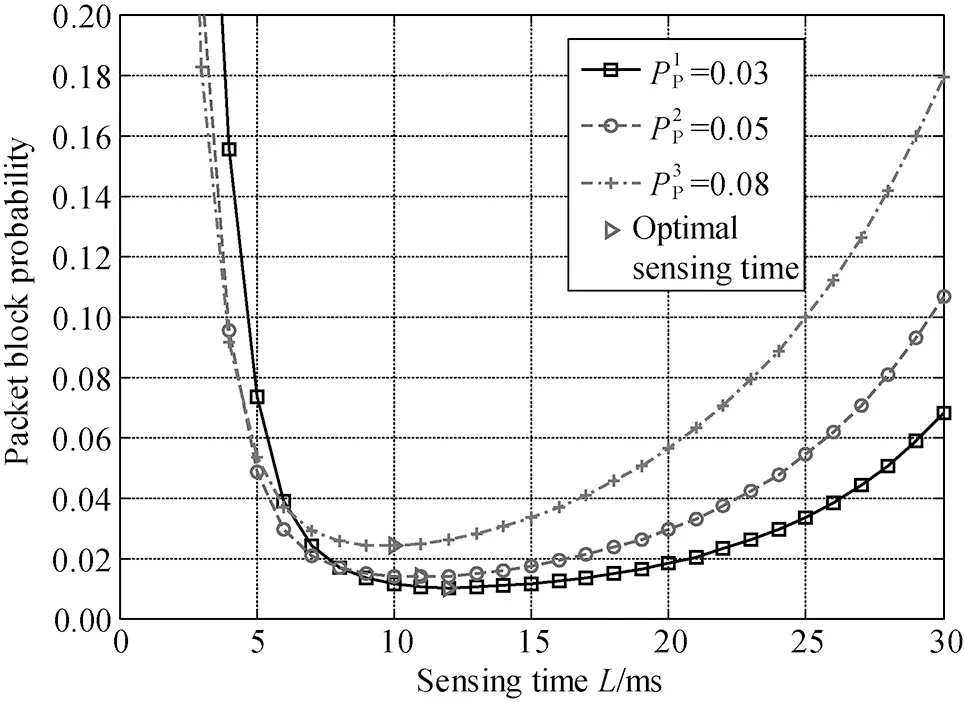
Fig.3 Sensing time L versus packet block probability
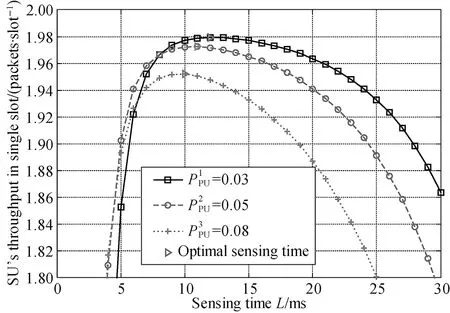
Fig.4 SU’s throughput in single slot with sensing time L
In long-term video transmission, three strategies are compared, which includes joint strategy (J-strategy), long-term strategy (L-strategy), and short-term strategy (S-strategy)[15]. The L-strategy focuses on the long-term optimization without considering the short-term optimization. Moreover, S-strategy focuses on the short-term optimization, while ignoring the long-term reward optimization. The PUs’ maximum tolerant collision probabilities at three channels are [0.01, 0.04, 0.07]. In Fig.5, we show that the comparison of three packet loss rates under different optimization strategies. In Fig.5, compared with L-strategy and S-strategy, SU with J-strategy can obtain the minimum packet loss rate in video transmission. The main reason is that SU can not only minimize the packet block probability in short-term transmission, but also efficiently reduce the long-term packet loss rate through learning from PUs’ activity information statistics. Furthermore, the packet loss rate of SU’s video packet decreases with time passing. It is because that SU can learn the DCRNs state information and intelligently access available channels to finish video transmission. Finally, SU with S-strategy has the lowest packet loss rate at the initial transmission time, since SU with J-strategy and L-strategy has no available states information of DCRNs.
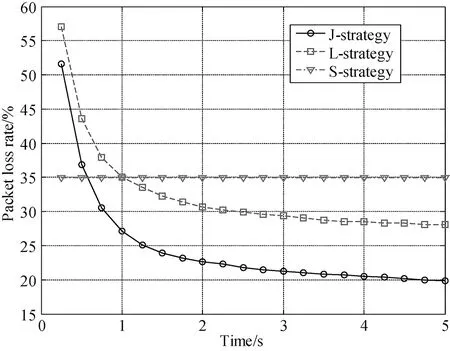
Fig.5 Comparison of three packet loss rates under different optimization strategies
Figure 6 compares SU’s average throughputs in each slot under three strategies. We can observe that as time elapses, both J-strategy and L-strategy have the higher average throughput in the long-term video transmission. Meanwhile, without the learning capability on S-strategy, the average throughput does not change with time.
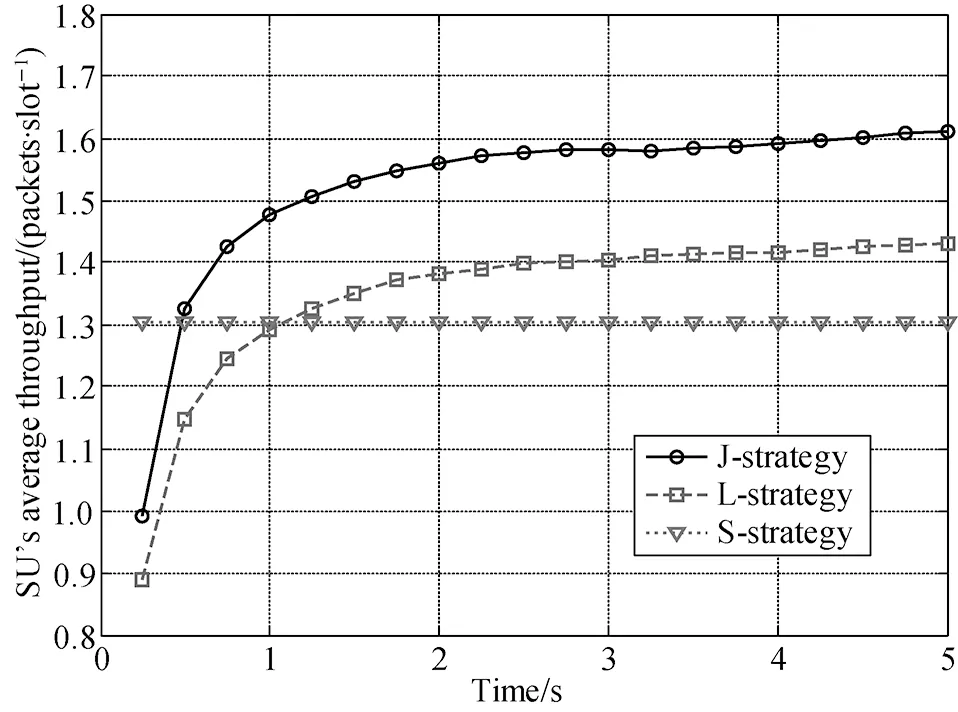
Fig.6 Comparison of SU’s average throughputs in each slot under different optimization strategies
Figure 7 illustrates the comparison of three packet loss rates with different PU’s tolerant collision probabilities, where PU’s tolerant probability set at three channels increases from [0.02, 0.02, 0.02] to [0.1, 0.1, 0.1]. It is observed that SU using the J-strategy in video transmission can obtain the minimum packet loss rate. Furthermore, PUs’ tolerant collision probabilities have little effect on SU’s packet loss rate of J-strategy. Figure 8 plots SU’s average throughputs under various PU’s tolerant collision probabilities. Note that the simulation parameters are the same as those in Fig.7. Meanwhile, we observe that SU with J-strategy has the highest average throughput as shown in Fig.8. Moreover, due to the little fluctuation on the packet loss rate, the throughput using J-strategy also is less impacted than the other throughputs with two strategies.
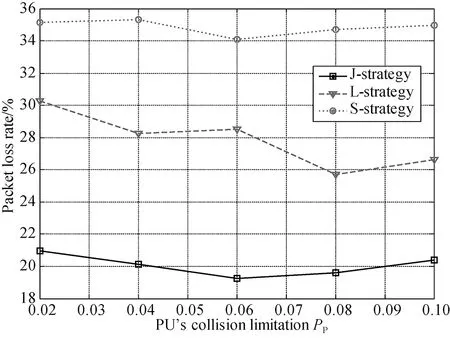
Fig.7 Comparison of three packet loss rates with different PU’s tolerant collision probabilities
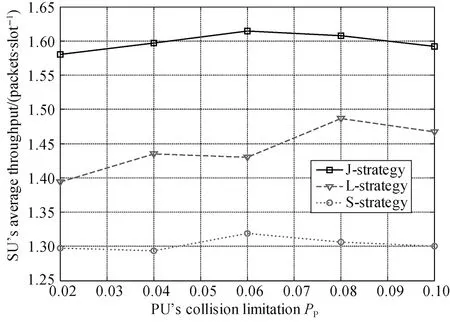
Fig.8 SU’s average throughputs with different PU’s tolerant collision probabilities
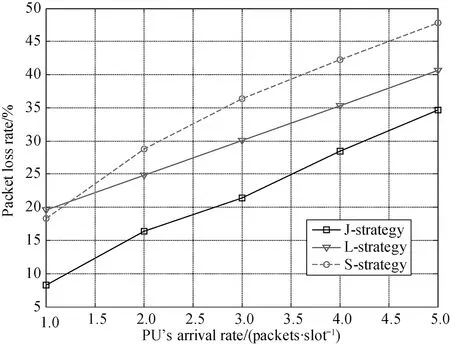
Fig.9 Three packet loss rates with different PUs’ arrival rates
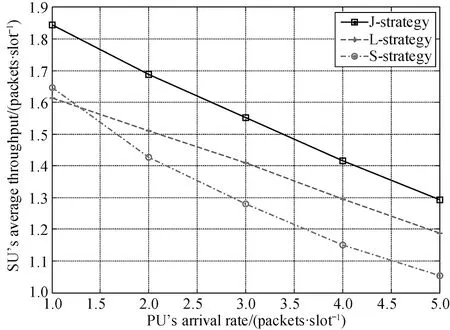
Fig.10 SU’s throughputs under various PU’s arrival rates
Figures 9 and 10 compare SU’s three packet loss rates and average throughputs under different PUs’ arrival rate, where the arrival rate λPat three channels is increasing from [1, 1, 1] (packets/slot) to [5, 5, 5] (packets/slot). PUs’ tolerant collision probabilities at three channels are [0.01, 0.04, 0.07]. As shown in Fig.9, we notice that SU adopting the J-strategy has the lowest packet loss rate. Meanwhile, the packet loss rates increase when PUs’ arrival rates incline. The reason is the increasing PU’s arrival rate curtails SU’s practical service rate, which is obtained by Eq.(5). In Fig.10, corresponding to the packet loss rate in Fig.9, SU with J-strategy has the highest average throughput. Inevitably, SU’s average throughput also decreases as PU’s arrival rate increases.
In Fig.11, the qualities of video stream under three transmission strategies (J-strategy, L-strategy, and S-strategy) are compared. The H.264/AVC JM 12.2 software is adopted to code the bus video with 417 frame, which consists of 3417 packets (the size of each packet is 1000 bits). The third frame is illustrated in Fig.11. The packet loss rate under three transmission strategies from Fig.5 is [20.0%, 27.3%, 34.9%]. As shown in the box of Fig.11, the quality of the third frame using J-strategy has the best performance among three transmission strategies. The peak signal to noise ratio (PSNR) with J-strategy has the highest value, which is 28.42 dB. The PSNRs of L-strategy and S-strategy are 23.85 and 22.80 dB, respectively.

(a) Original video frame No.3

(b) Reconstructed frame with J-strategy

(c) Reconstructed frame with L-strategy
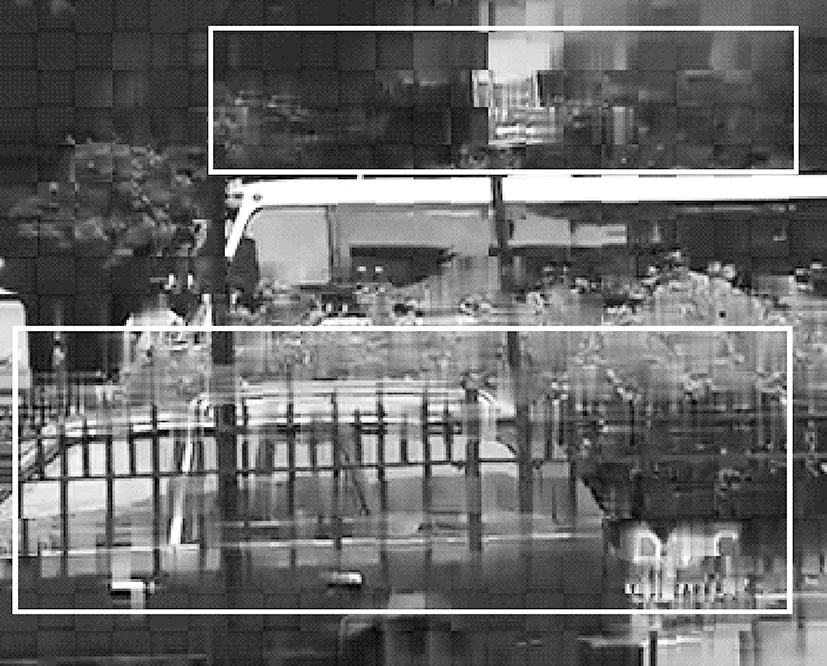
(d) Reconstructed frame with S-strategy
4 Conclusions
In this paper, we propose the J-strategy for independent SU to jointly consider the short-term and long-term optimizations in video transmission. In the short-term video transmission, considering a sequence of the factors over DCRNs, such as non-synchronization between SU and PU, PU’s tolerant collision probability limitation, and SU’s limited buffer size, the minimum packet block probability in each slot is obtained. Furthermore, combining the minimum packet block probability, we propose the POMDP framework and obtain the J-strategy. Meanwhile, under the proposed strategy, the packet loss rate is minimized in the long-term video transmission. Finally, the simulation results prove SU with J-strategy can effectively reduce the packet loss rate and improve the PSNR of video transmission.
[1] III J M. Cognitive Radio: an Integrated Agent Architecture for Software Defined Radio [D]. Sweden: Royal Institute of Technology (KTH), 2000: 1-303.
[2] Haykin S. Cognitive Radio: Brain-Empowered Wireless Communications [J].IEEEJournalonSelectedAreasinCommunications, 2005, 23(2): 201-220.
[3] Hattab G, Ibnkahla M. Multiband Spectrum Access: Great Promises for Future Cognitive Radio Networks [J].ProceedingoftheIEEE, 2014, 102(3): 282-306.
[4] Hasegawa M, Hirai H, Nagano K,etal. Optimization for Centralized and Decentralized Cognitive Radio Networks [J].ProceedingoftheIEEE, 2014, 102(4): 574-584.
[5] Zhao Q, Tong L, Swami A,etal. Decentralized Cognitive MAC for Opportunistic Spectrum Access in Ad Hoc Networks: a POMDP Framework [J].IEEEJournalonSelectedAreasinCommunications, 2007, 25(3): 589-600.
[6] Chen Y X, Zhao Q, Swami A. Joint Design and Separation Principle for Opportunistic Spectrum Access in the Presence of Sensing Errors [J].IEEETransactionsonInformationTheory, 2008, 54(5): 2053-2071.
[7] Yu F R, Sun B, Krishnamurthy V,etal. Application Layer QoS Optimization for Multimedia Transmission over Cognitive Radio Networks [J].WirelessNetworks, 2010, 17(2): 371-383.
[8] Liang Y C, Zeng Y H, Peh E C Y,etal. Sensing-Throughput Tradeoff for Cognitive Radio Networks [J].IEEETransactionsonWirelessCommunications, 2008, 7(4): 1362-1337.
[9] Luis M, Furtado A, Oliveira R,etal. Towards a Realistic Primary Users’ Behavior in Single Transceiver Cognitive Networks [J].IEEECommunicationsLetters, 2013, 17(2): 309-312.
[10] Choi K W. Adaptive Sensing Technique to Maximizing Spectrum Utilization in Cognitive Radio [J].IEEETransactionsonVehicularTechnology, 2010, 59(2): 992-998.
[11] Luo H Y, Ci S, Wu D L. A Cross-Layer Design for the Performance Improvement of Real-Time Video Transmission of Secondary Users over Cognitive Radio Networks [J].IEEETransactionsonCircuitsandSystemsforVideoTechnology, 2001, 21(8): 1040-1048.
[12] Jiang T G, Wang H G, Vasilakos A V. QoE-Driven Channel Allocation Schemes for Multimedia Transmission of Priority-Based Secondary Users over Cognitive Radio Networks [J].IEEEJournalonSelectedAreasinCommunications, 2012, 30(7): 1215-1224.
[13] Trees H L V. Detection,Estimation, and Modulation Theory, Part I [M]. New York, USA: Wiley-Interscience, 2001: 777-796.
[14] Murphy K P. A Survey of POMDP Solution Techniques [DB/OL]. (2000-09-09) [2014-07-01]. http://www.cs.ubc.ca/~murphyk/Papers/pomdp.pdf.
[15] Chen C L, Song M, Xin C S,etal. A Game-Theoretical Anti-jamming Scheme for Cognitive Radio Networks [J].IEEENetwork, 2013, 27(3): 22-27.
Foundation item: National Natural Science Foundation of China (No.61301101)
TN929.5 Document code: A
1672-5220(2015)01-0013-06
Received date: 2014-07-08
* Correspondence should be addressed to LIU Fa, E-mail: silent_0602@163.com
杂志排行
Journal of Donghua University(English Edition)的其它文章
- Asymptotic Behavior of the Drift Coefficient Estimator of Stochastic Differential Equations Driven by Small Noises
- Adaptive Modulation and Coding Based on Fuzzy Logic Cognitive Engine
- Modeling and Simulation of P-Aloha, CSMA/CA and MACAW Protocols for Underwater Acoustic Channel
- Design and Analysis of Axial Thrust Roller-Exciting Vibrating Table and Its Motor-Control System Based on Co-simulation
- Effects of Compression Garments on Lower Limb Muscle Activation via Electromyography Analysis during Running
- Analysis on Nipper Balance Shaft Movement with Transmission Drive of Comber
